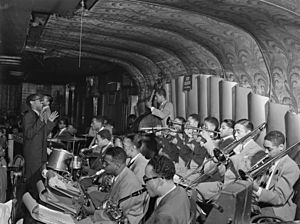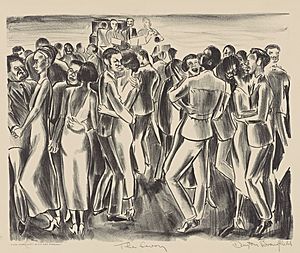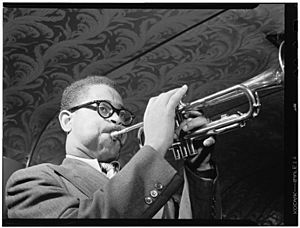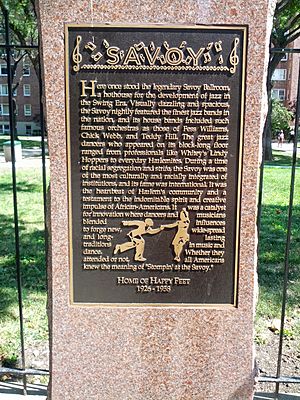Savoy Ballroom facts for kids

The Savoy Ballroom was a very large and famous dance hall. It was located in the Harlem neighborhood of Manhattan, New York City. You could find it on Lenox Avenue, between 140th and 141st Streets. Lenox Avenue was a main street in upper Harlem. The poet Langston Hughes called it the "Heartbeat of Harlem."
The Savoy was one of many popular spots in Harlem. But it was known as the "World's Finest Ballroom." It opened on March 12, 1926, and closed on July 10, 1958. It was more than just a building; it was the "soul" of its neighborhood. White businessman Jay Faggen and Jewish businessman Moe Gale owned it. An African-American businessman named Charles Buchanan managed the ballroom. He wanted a fancy place where many people could dance in a nice setting.
Contents
History of the Savoy Ballroom

The Savoy was designed like another ballroom called the Roseland Ballroom. The Roseland was mostly for European American swing dancers. As swing dance became popular, Harlem grew into a strong black community. The Savoy gave talented black dancers a beautiful place to dance.
The ballroom itself was huge, about 10,000 square feet. It was on the second floor and stretched a whole block. Up to 4,000 people could fit inside. The walls were pink and covered with mirrors. Colorful lights shone on the special wood dance floor. When it opened in 1926, the Savoy had a big lobby. It featured a large, sparkling chandelier and a marble staircase. Dancer Leon James said, "My first impression was that I had stepped into another world." He added that it was "much bigger, more glamour, real class."
The Savoy Ballroom was named after the famous Savoy Hotel in London. This name made the ballroom sound fancy and high-class.
The Savoy was popular right from the start. A newspaper headline from March 20, 1926, read: "Savoy Turns 2,000 Away On Opening Night." Crowds filled the ballroom all week. The ballroom stayed open every night.
Home of the Lindy Hop
The best Lindy Hop dancers, known as "Savoy Lindy Hoppers," were always at the Savoy. Sometimes, groups like Whitey's Lindy Hoppers became professional. They performed in Broadway shows and Hollywood movies. Herbert White, a bouncer at the Savoy, became a floor manager. He was known as Whitey because of a white streak in his hair. He looked for dancers who were "young, stylized, and, most of all, they had to have a beat."
Unlike many other clubs, like the Cotton Club, the Savoy welcomed everyone. It did not allow discrimination. About 85% of the people were black and 15% were white. Sometimes, it was an even mix. Lindy hop dancer Frankie Manning said people were judged by their dancing, not their skin color. He recalled, "All they wanted to know when you came into the Savoy was, do you dance?"
The best dancers often gathered in the northeast corner of the dance floor. This spot was called "Cats' Corner." Some say only Whitey's Lindy Hoppers could dance there. Others say it was open to any great dancer. Getting a spot in Cats' Corner was tough. Every serious dancer looked forward to the nightly "showtime." Other dancers would form a circle around the band. Then, "only the greatest Lindy-hoppers would stay on the floor."
Many dances were created and became famous at the Savoy. The Lindy Hop was one of them. It was named after Charles Lindbergh in 1927. Downtown, the Savoy was called the "Home of Happy Feet." But in Harlem, it was known as "the Track" because its dance floor was long and thin. Other dances born at the Savoy include The Flying Charleston, Jive, Snakehips, Rhumboogie, and different versions of the Shimmy and Mambo.
The ballroom made a lot of money. In its best years, from the late 1920s to the 1940s, it earned about $250,000 each year. Nearly 700,000 people visited the ballroom every year. The entrance fee was 30 to 85 cents per person. In 1936, the Savoy made enough money to spend $50,000 on remodeling.
Music and Entertainment
The ballroom had two bandstands on its east wall. One was large, and one was medium-sized. Music played all the time. As one band finished, the other was ready to start. The bouncers were strong men who had been boxers or basketball players. They wore tuxedos and earned $100 a night. A security team of four men watched the floor. No man was allowed in without a jacket and tie.
The Savoy also had "Harlem's most beautiful women" as Savoy Hostesses. They would teach people to dance. They were also dance partners for anyone who bought a 25-cent dance ticket. The dance floor was used so much that it had to be replaced every three years.
In the 1930s, Chick Webb led the Savoy's most popular house band. Ella Fitzgerald became the band's teenage singer in 1934. She had just won a talent show at the Apollo Theater. Chick Webb's band also recorded the famous song "Stompin' at the Savoy" in 1934.
The Savoy was famous for its "Battle of the Bands" or "Cutting Contests." These started when the Benny Goodman Orchestra challenged Webb in 1937. Webb and his band won that contest. In 1938, the Count Basie Band challenged Webb. Webb was declared the winner again. However, some people disagreed about who truly won.
Floating World Pictures made a documentary film about the ballroom called The Savoy King. It was shown at the 50th New York Film Festival. Other famous bandleaders at the Savoy included Al Cooper, Erskine Hawkins, Lucky Millinder, Buddy Johnson, and Cootie Williams.
The Savoy also took part in the 1939 New York World's Fair. It presented a show called "The Evolution of Negro Dance." In April 1943, the ballroom temporarily closed due to some issues with the police. Its license was renewed later that year in October.
Demolition and Legacy
The Savoy Ballroom closed for good in October 1958. Many people tried to save it, including Borough President Hulan Jack and manager Charles Buchanan. But the Savoy Ballroom was torn down in March and April 1959. This happened to make way for a new housing complex called Delano Village. The mayor faced protests from clubs and groups. The items from the ballroom were sold off for the housing project.
Count Basie said, "With the passing of the Savoy Ballroom, a part of show business is gone."
On May 26, 2002, Frankie Manning and Norma Miller unveiled a special plaque. They were members of Whitey's Lindy Hoppers. This plaque remembers the Savoy Ballroom on Lenox Avenue.
On the 19th anniversary of the plaque, the Savoy Ballroom was honored with an interactive Google Doodle. This was a fun rhythm game that featured popular swing dance songs. One song was "Let's Call the Whole Thing Off" by Ella Fitzgerald and Louis Armstrong.
See also
 In Spanish: Savoy Ballroom para niños
In Spanish: Savoy Ballroom para niños
- List of jazz clubs



